California is home to an incredibly diverse range of birds, from small sparrows to majestic pelicans. With its wide variety of habitats, from coastal wetlands to mountain forests, the state has an equally wide variety of bird species.
From the iconic California condor to the colorful western tanager, there are many fascinating birds to discover in California.
Whether you’re birding in the Redwood Forest or along the Pacific Coast, you’re sure to be amazed by the variety of species in the Golden State.
31 Common Californian Birds
California is a birdwatcher’s paradise, with a rich diversity of avian species that inhabit its varied landscapes. From the coast to the mountains, from the desert to the forest, you can find hundreds of different birds in the Golden State.
Here are 31 common Californian birds you might encounter on your next visit.
1. Anna’s Hummingbird
Anna’s hummingbird is a beautiful species belonging to the Trochilidae family. Native to western coastal regions of North America, it was named after Anna Masséna, Duchess of Rivoli.
In the early 20th century, these birds bred only in northern Baja California and southern California. Still, due to ornamental plant transplanting, they can now be found across much of the Pacific Coast region.
They are medium-sized with bright emerald green feathers on their back and crowns as well as rose-red patches at the throat for males, making them quite distinguishable from other birds.
Their diet consists mainly of nectar from flowers, although they will occasionally feed on insects or spiders, making them important pollinators that help maintain healthy ecosystems.
Scientific classification:
| Kingdom | Animalia |
| Phylum | Chordata |
| Class | Aves |
| Order | Apodiformes |
| Family | Trochilidae |
| Genus | Calypte |
| Species | C. anna |
2. California Scrub Jay
The California scrub jay is a bird species native to western North America. It can be found from southern British Columbia through California and western Nevada near Reno, up to the west beyond the Sierra Nevada range.
This beautiful blue feathered bird was once categorized with Woodhouse’s scrub jay as the “western scrub jay,” along with island scrub jays.
The California Scrub Jay has distinctive features such as its greyish-blue feathers on its head, wings, and tail; white cheeks; dark bill; and strong legs for perching in trees, which makes it stand out among other birds in its family.
Scientific classification:
| Kingdom | Animalia |
| Phylum | Chordata |
| Class | Aves |
| Order | Passeriformes |
| Family | Corvidae |
| Genus | Aphelocoma |
| Species | A. californica |
Also Featured In: Blue Birds You’ll Found around Us, Birds Live Near San Diego
3. Allen’s Hummingbird
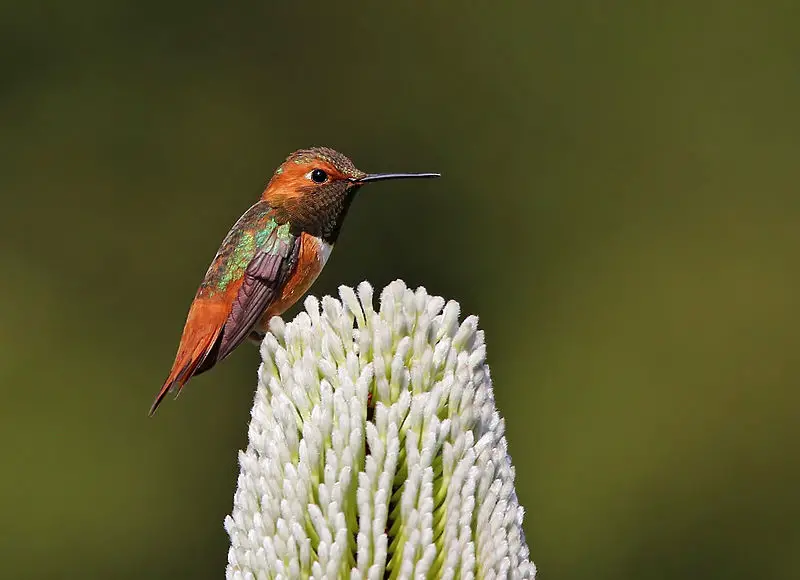
Allen’s Hummingbird is a beautiful species of hummingbird that breeds in the western United States. It is only 3-3.5 inches long, and its stunningly vibrant plumage makes it an incredible sight.
The male has a green back and forehead, with rust-colored (rufous) flanks, rump, and tail, while his throat dazzles with an iridescent orange coloration.
Females are similarly colored but lack the colorful throat patch of males.
These birds feed primarily on nectar from flowers such as sagebrush, California fuchsia, or currant bushes, using their long bills and tongues to extract food deep within them.
They also eat small insects for protein, which they capture in flight like other hummingbirds.
Allen’s Hummingbird can be found near chaparral shrubland during breeding season when wildflowers abound, giving these tiny beauties plenty of sustenance.
Scientific classification:
| Kingdom | Animalia |
| Phylum | Chordata |
| Class | Aves |
| Order | Apodiformes |
| Family | Trochilidae |
| Genus | Selasphorus |
| Species | S. sasin |
4. California Towhee
The California towhee (Melozone crissalis) is a medium-sized bird from the family Passerellidae.
It can be found in the coastal regions of Oregon, California, and Baja California Sur in Mexico.
This species has been subject to taxonomic debate – some authors place it within Fringillidae instead.
The male Californian towhee is easily identified by its greyish-brown plumage with black streaks on its back, tail, and wings, while females have duller colors than males but still retain the same patterned feathering.
Additionally, they possess an orange-colored bill and legs, adding a pop of color to their otherwise dusky appearance.
Scientific classification:
| Kingdom | Animalia |
| Phylum | Chordata |
| Class | Aves |
| Order | Passeriformes |
| Family | Passerellidae |
| Genus | Melozone |
| Species | M. crissalis |
Also Featured In: Common Southern Californian Birds, Birds that Live in San Francisco Bay Area
5. New World Quail
New World quail are small birds found in the Americas, from Canada to Brazil. They belong to their own family, Odontophoridae, and have similar appearances and habits as Old World quail, which belong to a different family.
New World Quails come in various species, such as California Quail and Bobwhite Quail.
These birds have adapted well to human presence due to the availability of food resources like crops.
They also live close together, forming large flocks for safety against predators like foxes or hawks.
The males usually sport colorful feathers during mating season that help them attract female mates while providing an amazing sight for viewers.
Scientific classification:
| Kingdom | Animalia |
| Phylum | Chordata |
| Class | Aves |
| Order | Galliformes |
| Superfamily | Phasianoidea |
| Family | Odontophoridae Gould, 1844 |
6. California Quail
The California quail is a small, ground-dwelling bird with an iconic drooping crest. Male birds have dark brown caps and black faces, while females sport brown backs and white streaks on their flanks.
These quails are found in the western United States and parts of northern Mexico and may gather in groups to feed or dust bathe together during the day.
Their diet consists mainly of grasses, seeds, berries, and some insects like beetles or ants.
The population has been declining due to habitat loss, so conservation efforts are being implemented for the survival of this species.
Scientific classification:
| Kingdom | Animalia |
| Phylum | Chordata |
| Class | Aves |
| Order | Galliformes |
| Family | Odontophoridae |
| Genus | Callipepla |
| Species | C. californica |
7. Snowy Plover
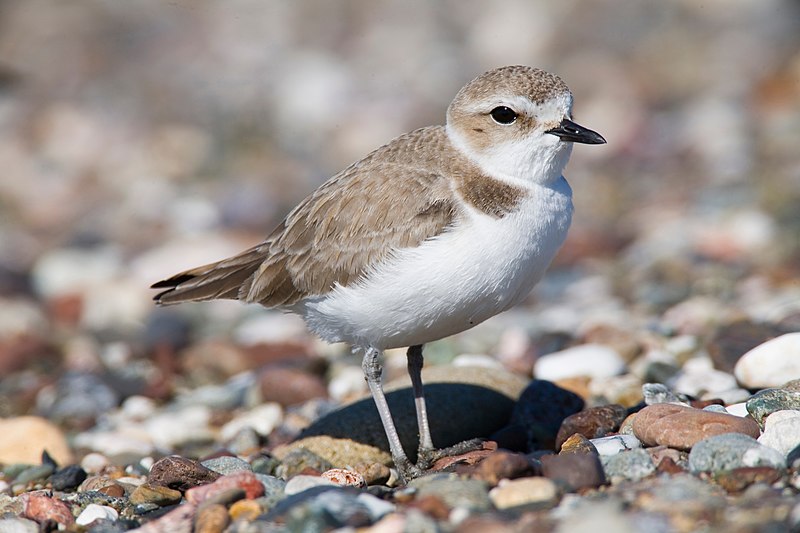
The Snowy Plover is a small wader bird, about 5-7″ long. It breeds in the southern and western United States, the Caribbean, Ecuador, Peru, and Chile.
Once considered a subspecies of the Kentish plover, it has since been reclassified as its species.
To protect nesting areas along Central California’s coastlines, parts or entire beaches are closed off during breeding season for this endangered species.
This rare bird can easily be identified by its sandy brown color with white underbelly that helps camouflage itself from predators while on land but stands out when taking flight due to its brilliant white wingspan which provides an eye catching display against blue sky backdrop.
Scientific classification:
| Kingdom | Animalia |
| Phylum | Chordata |
| Class | Aves |
| Order | Charadriiformes |
| Family | Charadriidae |
| Genus | Charadrius |
| Species | C. nivosus |
Also Featured In: Birds of Oregon Coast, Birds That Live In Gasparilla Island
8. California Condor
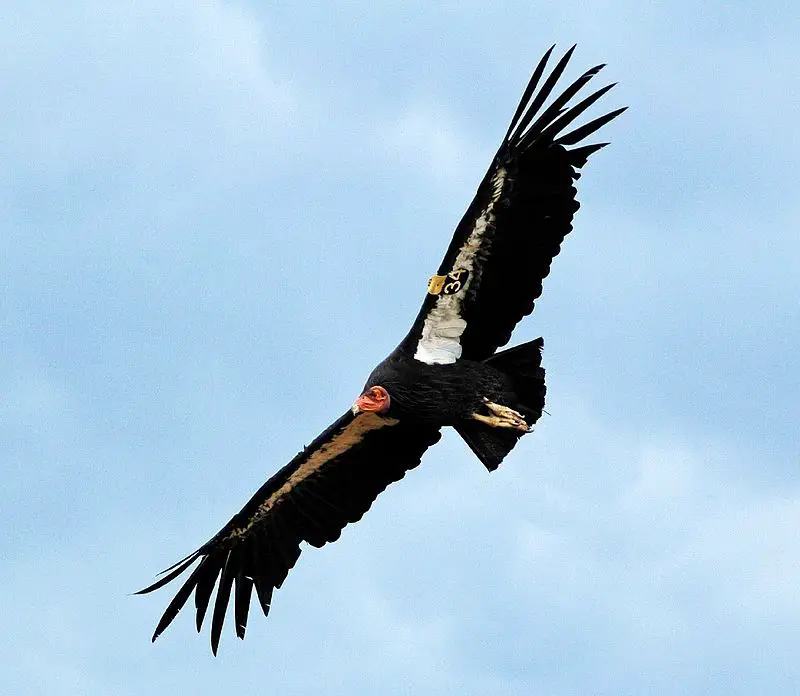
The California condor is a majestic bird, the largest North American land bird. Sadly, It was pushed to extinction in the wild in 1987 when all remaining individuals were captured.
Since then, conservation efforts have allowed for reintroducing these birds into northern Arizona and southern Utah, including Zion National Park and the Grand Canyon area, the coastal mountains of California, and northern Baja California.
The species has been given plenty of protection, with numerous laws created to protect it from human interference or disturbance while also helping boost its population size through captive breeding programs.
Thanks to this effort, we can now see this incredible species flying across our skies again.
Scientific classification:
| Kingdom | Animalia |
| Phylum | Chordata |
| Class | Aves |
| Order | Accipitriformes |
| Family | Cathartidae |
| Genus | Gymnogyps |
| Species | G. californianus |
Also Featured In: Birds You’ll Find in Zoo, Birds that Live in the Grand Canyon National Park
9. Oak Titmouse
The Oak Titmouse is a small passerine bird of the tit family, Paridae. It has an overall grayish-brown plumage with a cream-colored underside, and its face is plain in coloration, lacking any distinct patterning or markings.
However, the distinguishing feature of this species is the tufted crest on top of its head, which gives it a unique appearance.
They are native to western North America and inhabit oak woodlands and chaparral habitats at elevations between sea level up to 5500 feet above sea level.
These birds feed mostly on insects such as caterpillars but consume seeds and fruits during colder months when insect prey becomes scarce.
In addition, they have been seen stealing food from other birds’ nests, including acorn Woodpecker’s caches.
Scientific classification:
| Kingdom | Animalia |
| Phylum | Chordata |
| Class | Aves |
| Order | Passeriformes |
| Family | Paridae |
| Genus | Baeolophus |
| Species | B. inornatus |
10. Black Phoebe
The black phoebe is a beautiful passerine bird from the tyrant flycatcher family. It breeds from southwest Oregon and California south through Central and South America, where it can be found year-round.
However, its northern populations tend to migrate seasonally in some areas. Six subspecies of this species have been identified: two are occasional visitors, while the others are more common residents in their range.
The adult has mainly dark grey upperparts with a white belly; juveniles may show brownish tones instead of grey ones on their back.
Its main diet consists of insects it catches by hovering over water or flying out after them from perches near rivers or streams – hence why they’re often seen around these places.
Scientific classification:
| Kingdom | Animalia |
| Phylum | Chordata |
| Class | Aves |
| Order | Passeriformes |
| Family | Tyrannidae |
| Genus | Sayornis |
| Species | S. nigricans |
11. Tricolored Blackbird
The tricolored blackbird is a member of the Icteridae family and is found in coastal areas from Northern California to upper Baja California.
It’s an incredibly social and gregarious bird that loves forming huge colonies- bigger than any North American landbird.
The birds are striking with their black feathers, white shoulder patches, and yellowish beaks.
They build nests from grasses or weeds near water sources like wetlands or marshes.
Unfortunately, they have been steadily declining due to habitat destruction, although conservation efforts have helped stabilize their population in recent years.
With enough protection, we can ensure these beautiful creatures remain part of our ecosystem for future generations.
Scientific classification:
| Kingdom | Animalia |
| Phylum | Chordata |
| Class | Aves |
| Order | Passeriformes |
| Family | Icteridae |
| Genus | Agelaius |
| Species | A. tricolor |
Also Featured In: Black Birds that Live around United States of America,
12. Chestnut-Backed Chickadee
The Chestnut-backed Chickadee is a small passerine bird in the tit family, Paridae. It lives within the Pacific Northwest region of America and Canada, its range extending from southern Alaska to southwestern California.
This species remains a permanent resident throughout its area rather than migrating seasonally, although feeding flocks may temporarily move short distances for food sources.
They are commonly found in woodlands with dense understory vegetation and suburban gardens.
The male and female birds can be distinguished by their distinctive patterned plumage: males have brown backs while females are grayer above, but both share white bellies and buffy sides striped with black barring across their wings and tails.
These sociable birds usually feed on insects or seeds obtained from trees or shrubs using their sharp beaks.
Scientific classification:
| Kingdom | Animalia |
| Phylum | Chordata |
| Class | Aves |
| Order | Passeriformes |
| Family | Paridae |
| Genus | Poecile |
| Species | P. rufescens |
13. California Gull

The California Gull is a medium-sized bird, smaller than the herring gull but larger than the ring-billed gull. It has a yellow bill with a black ring and yellow legs.
Its head is rounder than other gulls, and its body is mainly white with grey back and wings.
They are mostly found around lakes, rivers, or coasts of western North America, where plenty of food, such as fish, insects, and crustaceans, is available for them, which they consume daily.
During the breeding season, these birds form large colonies near water bodies or wetlands, making their nests using grasses, sticks, or feathers.
As omnivores, they play an important role in maintaining balance within local ecosystems by eating plant material like seeds & fruits and small mammals like rodents.
Scientific classification:
| Kingdom | Animalia |
| Phylum | Chordata |
| Class | Aves |
| Order | Charadriiformes |
| Family | Laridae |
| Genus | Larus |
| Species | L. californicus |
14. Mountain Quail
The Mountain Quail is a unique ground-dwelling bird species found only in the New World quail family.
It stands an average length of 26 to 28 cm and has distinctive features such as long tail feathers, black tufts on either side of its head, and bold white bars across its wings.
This beautiful creature inhabits mountainous regions from coast to coast in western North America, particularly California’s coastal mountains.
Its diet consists mainly of seeds, insects, and other small animals found on the ground or in low shrubs. The mountain quail is known for its remarkable speed; they can easily run up steep hillsides.
Their specialized adaptations, like camouflage coloring, help them blend into rocky terrain, and thick brush coverings protect them from predators.
These birds have become highly successful at surviving in harsh conditions over millions of years – making them one impressive avian species.
Scientific classification:
| Kingdom | Animalia |
| Phylum | Chordata |
| Class | Aves |
| Order | Galliformes |
| Family | Odontophoridae |
| Genus | Oreortyx Baird, 1858 |
| Species | O. pictus |
15. Least Tern
The Least Tern is a species of tern native to North America and northern South America. It has many close relatives, such as the yellow-billed and Peruvian tern from South America or the little tern from the Old World.
The bird measures 8.7 – 9.4 inches in length with a wingspan of 16–18 inches across, making it an intermediate size between most other species of birds within its family groupings.
Its feathers are usually gray on top with white underneath. They typically have darker accents near their heads and bright red bills for feeding during summer when they mate upon beaches found throughout these regions mentioned above.
They feed mainly on small fish that live at shallow depths near shorelines and nest nearby due to migratory patterns that occur annually each year.
Hence, this bird does not travel long distances away from areas known as home for them over long periods like some other types do.
Scientific classification:
| Kingdom | Animalia |
| Phylum | Chordata |
| Class | Aves |
| Order | Charadriiformes |
| Family | Laridae |
| Genus | Sternula |
| Species | S. antillarum |
16. White-Tailed Kite
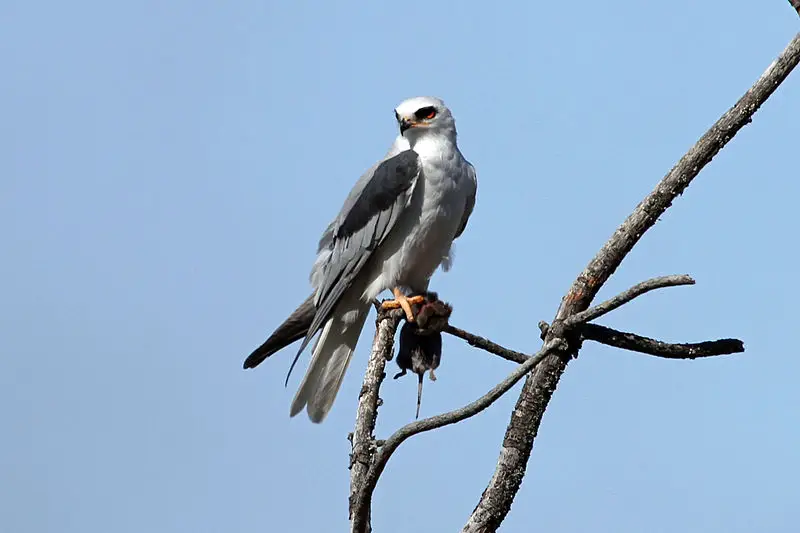
The White-tailed Kite is a small raptor found in western North America and parts of South America. It was first described by French ornithologist Louis Jean Pierre Vieillot in 1818, with the type locality being Paraguay.
This species belongs to the same family as Old World black-winged kites but is more widespread than its relative.
They are recognized easily due to their distinct white heads and tails, grey wings and backs, yellow eyes and legs.
These birds primarily hunt for rodents such as mice during daylight hours using their exceptional hunting skills, such as hovering midair before diving down on prey or swooping low over grasslands looking for food items on the ground.
In addition, they also feed upon insects, including grasshoppers and locusts, which provide them additional nutrition throughout the summer months.
Scientific classification:
| Kingdom | Animalia |
| Phylum | Chordata |
| Class | Aves |
| Order | Accipitriformes |
| Family | Accipitridae |
| Genus | Elanus |
| Species | E. leucurus |
Also Featured In: Everglades Birds, Black And White Birds You Don’t Know About
17. Western Bluebird
The Western Bluebird is a small North American thrush formally described by English naturalist William John Swainson in 1832.
It has six subspecies and measures 15 to 18 cm long, with the adult male being bright blue on top and light orange-brown underneath.
Its wings have white bars which contrast against its bright plumage. The female is duller overall but retains the same wing pattern as its counterpart.
In addition, it also sports an attractive reddish patch near its bill area when breeding season arrives.
This species can be found inhabiting open woodlands, grassy meadows, or agricultural areas of western America from Alaska southwards into Mexico and Guatemala, where they feed mainly on insects such as beetles, flies, ants, etc.
All in all, this gorgeous bird adds color to any environment.
Scientific classification:
| Kingdom | Animalia |
| Phylum | Chordata |
| Class | Aves |
| Order | Passeriformes |
| Family | Turdidae |
| Genus | Sialia |
| Species | S. mexicana |
18. American White Pelican
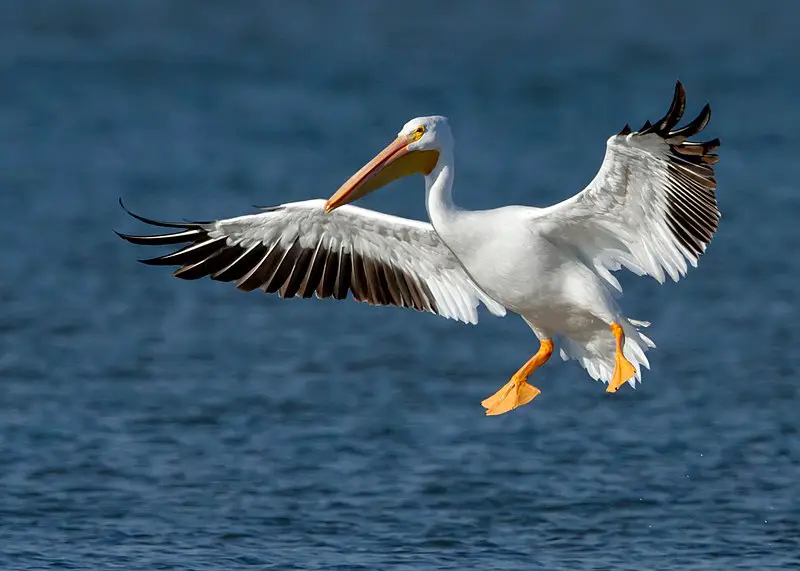
The American White Pelican is a majestic bird from the Pelecaniformes order, known for its impressive size and ability to soar gracefully in the sky.
It breeds during summer months in North America and migrates southwards towards Central and South America during winter.
The species was first described by German naturalist Johann Friedrich Gmelin back in 1789 as part of his updated version of Carl Linnaeus’ work.
This large aquatic bird has an all-white plumage with black primary flight feathers on its wings, while its beak features a characteristic yellowish coloration at the base near the face.
Its diet mainly consists of fish, which it typically catches after dipping into the water using its long bill; yet sometimes, they can be seen stealing food items from other birds, such as cormorants or gulls.
Scientific classification:
| Kingdom | Animalia |
| Phylum | Chordata |
| Class | Aves |
| Order | Pelecaniformes |
| Family | Pelecanidae |
| Genus | Pelecanus |
| Species | P. erythrorhynchos |
19. Gnatcatcher
Gnatcatchers are small passerine birds from the family Polioptilidae. They inhabit North and South America, apart from far south regions and high Andean areas.
Most species of this mostly tropical and subtropical group remain in one area year-round; however, the blue-grey gnatcatcher of the U.S.A. and Canada migrate to warmer climates during wintertime.
Gnatcatchers share a close relationship with wrens.[1] The size varies between 5–7 inches long depending on the species; they typically have dark upperparts while their underparts range in color: white or greyish shades may predominate, but some species show yellow tinting, too.
Their diet consists mainly of insects, usually captured by short sallies above vegetation level when foraging for food.
Scientific classification:
| Kingdom | Animalia |
| Phylum | Chordata |
| Class | Aves |
| Order | Passeriformes |
| Superfamily | Certhioidea |
| Family | Polioptilidae Baird, 1858 |
20. Heermann’s Gull
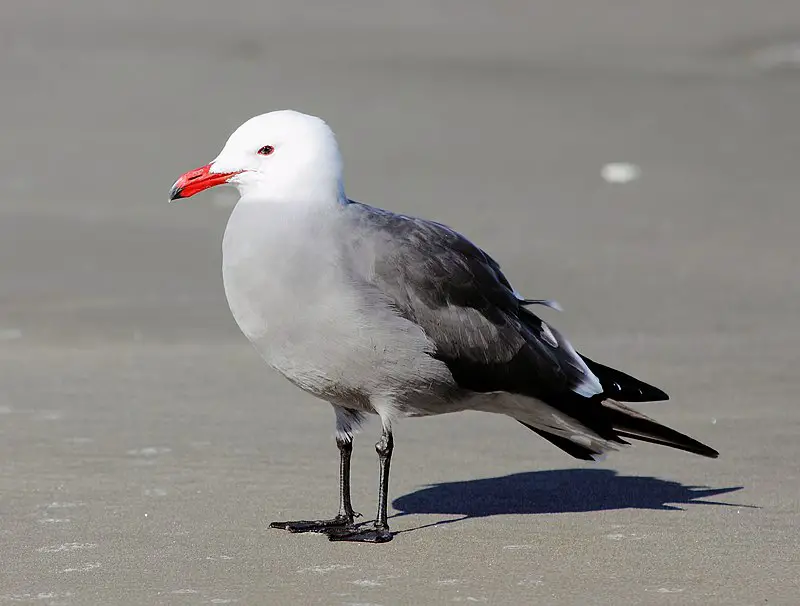
Heermann’s gull is a type of seabird found in the United States, Mexico, and British Columbia. It nests on Isla Rasa in the Gulf of California and can be seen near shores or at sea, though rarely inland.
Named after Adolphus Lewis Heermann, a nineteenth-century explorer and naturalist, this species looks quite different from other gulls due to its brownish coloring with white spots around the wings.
It has bright yellow legs and red eyes circled by an orange ring – features that make it easily identifiable among bird watchers.
Their diet consists mainly of fish, but they will also eat insects, crustaceans, and mollusks if necessary.
Although not considered endangered, their numbers have decreased over time, so conservation efforts are imperative for these beautiful birds.
Scientific classification:
| Kingdom | Animalia |
| Phylum | Chordata |
| Class | Aves |
| Order | Charadriiformes |
| Family | Laridae |
| Genus | Larus |
| Species | L. heermanni |
21. Costa’s Hummingbird
Costa’s hummingbird is a species of the Trochilidae family. It inhabits arid regions in the southwest United States and northwest Mexico, migrating to western Mexico for wintering purposes.
This bird was named by French ornithologist Jules Bourcier in 1839 after honoring François Coste, who had sent specimens to him from North America.
Costa’s hummingbirds are small birds averaging 3-3.5 inches (7–9cm) long with typically green feathers on their back and tail. At the same time, underparts are usually greyish or sometimes white with purple highlights around the throat area, giving them an iridescent appearance when light hits them at the right angle.
Males also have red patches on their forehead, which they use as part of courtship display behavior, and sing distinctive “whoop” sounds during mating season.
Scientific classification:
| Kingdom | Animalia |
| Phylum | Chordata |
| Class | Aves |
| Order | Apodiformes |
| Family | Trochilidae |
| Genus | Calypte |
| Species | C. costae |
22. Western Snowy Plover
The western snowy plover is a small wader belonging to the plover bird family. It breeds in various areas of the United States and the Caribbean, but its population has decreased over time due to habitat loss and other threats.
For this reason, on March 5th, 1993, it was listed as a threatened species under the Endangered Species Act of 1973.
To protect their habitats along California’s coast, Oregon’s coast, and Washington’s coasts, they have also been designated as critical habitats by The U.S. Fish & Wildlife Service in 2012.
Conservation efforts are being taken for these birds, including beach closures during nesting season; however, more must be done to protect them from extinction. We must take action now before it’s too late.
Scientific classification:
| Kingdom | Animalia |
| Phylum | Chordata |
| Class | Aves |
| Order | Charadriiformes |
| Family | Charadriidae |
| Genus | Charadrius |
| Species | C. nivosus |
| Subspecies | C. n. nivosus |
Also Featured In: Estuaries Birds,
23. Bewick’s Wren
The Bewick’s wren (Thryomanes bewickii) is a small, grey-brown bird native to North America. Measuring around 14 cm long, it has distinctive white markings on its face and tail, giving it an attractive appearance.
It can often be found in thickets or scrubby areas, urban gardens, and parks.
Its loud and melodious songs make them popular amongst ornithologists; they are known for their complex vocalizations composed of whistles, clicks, churrs, and trills.
The Bewick’s Wren mainly feeds on insects but will also eat fruits if available during the colder months when food is scarce.
This species of wren plays an important role in controlling insect populations, making them beneficial inhabitants of our environment.
Scientific classification:
| Kingdom | Animalia |
| Phylum | Chordata |
| Class | Aves |
| Order | Passeriformes |
| Family | Troglodytidae |
| Genus | Thryomanes P.L. Sclater, 1862 |
| Species | T. bewickii |
24. White-Headed Woodpecker
The white-headed woodpecker is a beautiful, non-migratory bird native to the pine forests of western North America.
It has a black body measuring 20 cm long and a distinctively white head with crescent-shaped primary feathers.
The male also features an attractive red spot at the back of its head as well.
This range stretches from British Columbia down through California, Arizona, and New Mexico; they typically inhabit elevations ranging between 900–3000 m above sea level but can occasionally be found up to 4200 m.
They are omnivorous birds that feed mainly on insects such as ants and beetles, although they will occasionally supplement their diet with fruits or nuts when available.
All in all, this truly remarkable species offers much for us to admire about it.
Scientific classification:
| Kingdom | Animalia |
| Phylum | Chordata |
| Class | Aves |
| Order | Piciformes |
| Family | Picidae |
| Genus | Leuconotopicus |
| Species | L. albolarvatus |
25. Lawrence’s Goldfinch
Lawrence’s Goldfinch is a small songbird in California and Baja California, the southwestern United States, and northern Mexico.
They measure about 4.75 inches long and weigh 0.4 ounces, making them slightly bigger than their lesser cousin but smaller than American Goldfinches with less yellow plumage.
These birds feed on plant matter, such as seeds from grasses or sunflowers, which are stored for later use in winter when food sources become scarce; however, they also eat insects during nesting season to give extra protein to their young chicks.
Their colorful nature makes them popular amongst bird watchers who love to observe these impressive creatures up close while they flit around gardens, parks, meadows, or open woodlands, singing sweetly along the way.
Scientific classification:
| Kingdom | Animalia |
| Phylum | Chordata |
| Class | Aves |
| Order | Passeriformes |
| Family | Fringillidae |
| Subfamily | Carduelinae |
| Genus | Spinus |
| Species | S. lawrencei |
26. Black-Chinned Sparrow
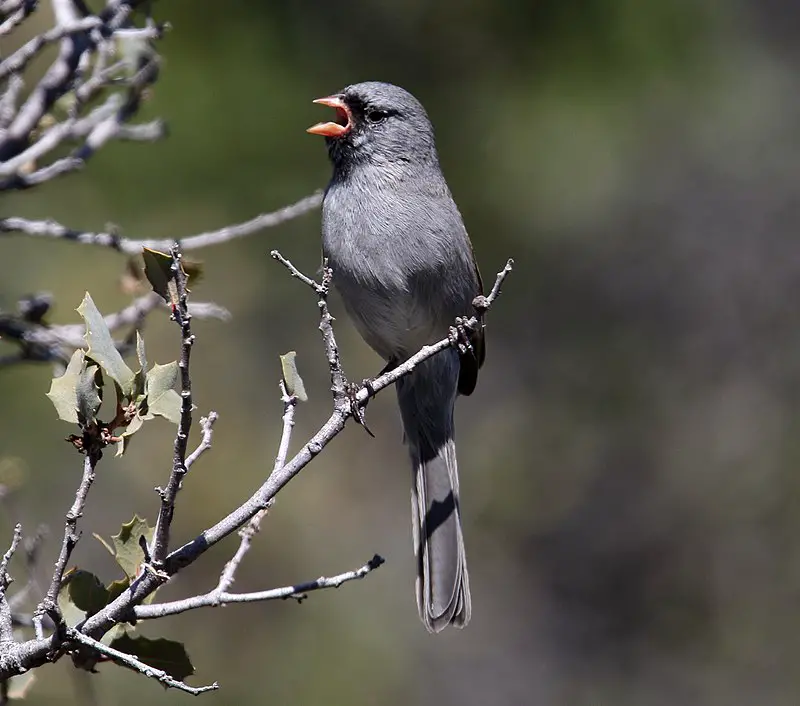
The Black-chinned Sparrow is a small, slim bird found in the southwestern United States and Mexico. It has gray plumage with reddish-brown on its wings, tail feathers, and black chin.
Its long tail helps it to maneuver quickly through dense vegetation when searching for food or seeking shelter from predators.
This species migrates south after breeding during summer, while those living in Mexico are year-round residents of their habitat.
The diet consists mainly of seeds, but they will also eat insects such as grasshoppers, caterpillars, spiders, and other invertebrates for protein-rich nutrition, supplementing their seed-based diet.
They require open habitats like grasslands to find food sources, so conservation efforts focus on providing these important habitats throughout their range.
This includes avoiding land conversion into agricultural areas that could impact them adversely if local authorities do not manage them properly.
Scientific classification:
| Kingdom | Animalia |
| Phylum | Chordata |
| Class | Aves |
| Order | Passeriformes |
| Family | Passerellidae |
| Genus | Spizella |
| Species | S. atrogularis |
27. Northern Pygmy Owl
The Northern Pygmy Owl is a small species of owl native to western North America. It has mottled brown and white feathers, yellow eyes, and a relatively long tail for its size.
They are fairly common in the area they inhabit but have disappeared from some areas due to habitat loss and other factors.
These owls feed on insects, rodents, lizards, and frogs in their natural habitats, including open woodlands such as coniferous forests or riparian corridors along rivers or streams where plenty of trees can perch while hunting.
Despite their diminutive size these birds can be surprisingly loud with calls that range from short barks to high-pitched whistles meant as territorial warnings against predators like hawks or cats who might try to make a meal out of one of these tiny hunters.
Scientific classification:
| Kingdom | Animalia |
| Phylum | Chordata |
| Class | Aves |
| Order | Strigiformes |
| Family | Strigidae |
| Genus | Glaucidium |
| Species | G. californicum |
28. California Thrasher
The California thrasher is a member of the Mimidae family and is found in chaparral habitats in both California and Baja California. It has grey-brown upperparts, white underparts with pale streaks, yellow eyes, and a black bill.
Its long tail helps it forage through dense vegetation and aids its agility when climbing trees or shrubs.
The species’ diet consists mainly of insects such as beetles, ants, and grasshoppers but can also feed on small fruits like berries or seeds from wildflowers.
It builds an open cup nest out of twigs, stems, and leaves, lined with soft material like feathers or fur near the base of bushes or low tree branches.
This bird forms part of a superspecies along with the crissal thrasher (Toxostoma crissale) and LeConte’s thrasher (Toxostoma lecontei).
Scientific classification:
| Kingdom | Animalia |
| Phylum | Chordata |
| Class | Aves |
| Order | Passeriformes |
| Family | Mimidae |
| Genus | Toxostoma |
| Species | T. redivivum |
Also Featured In: Birds that Live in Chaparral,
29. California Gnatcatcher
The California gnatcatcher is a small, insectivorous bird that inhabits dense coastal sage scrub growth.
It measures 10.8 cm (4.3 in) long and has recently been split from the similar black-tailed gnatcatcher of the Sonoran and Chihuahuan deserts due to differences in plumage coloration.
The male has dusky grey feathers overall with white underparts, while the female is brownish above with dull yellow underparts.
During winter, these birds often form flocks but are usually solitary during other times, making them hard to spot amongst their natural habitat’s foliage.
They feed on various insects, such as flies, beetles, spiders, and grasshoppers found within their environment.
Scientific classification:
| Kingdom | Animalia |
| Phylum | Chordata |
| Class | Aves |
| Order | Passeriformes |
| Family | Polioptilidae |
| Genus | Polioptila |
| Species | P. californica |
30. Yellow-Billed Magpie
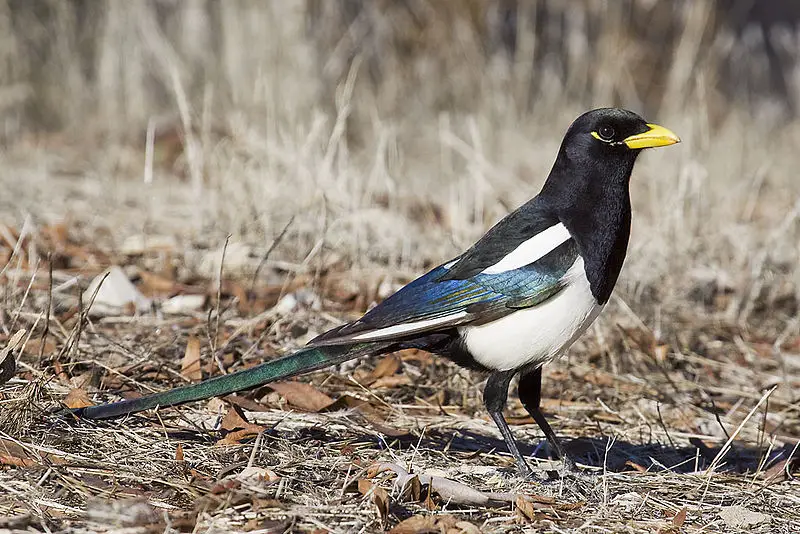
The Yellow-billed Magpie is a large bird found in the U.S. state of California, specifically in its Central Valley and adjacent foothills and mountains.
It has a distinctive yellow bill and a bright yellow streak around its eye, distinguishing it from other magpies, such as the black-billed magpie found elsewhere throughout North America.
Its diet consists mainly of insects, fruit, and small mammals like rodents. Still, they will also scavenge for food where possible – meaning they are often seen on roadsides or near human habitation due to trash availability.
They live within flocks ranging from two birds to huge numbers estimated at over several hundred individuals.
In addition to their loud calls when flying together, these birds have various vocalizations, including whistles, chirps, and rattles, used during courtship displays or as warning signals against predators.
Scientific classification:
| Kingdom | Animalia |
| Phylum | Chordata |
| Class | Aves |
| Order | Passeriformes |
| Family | Corvidae |
| Genus | Pica |
| Species | P. nuttalli |
31. Western Gull
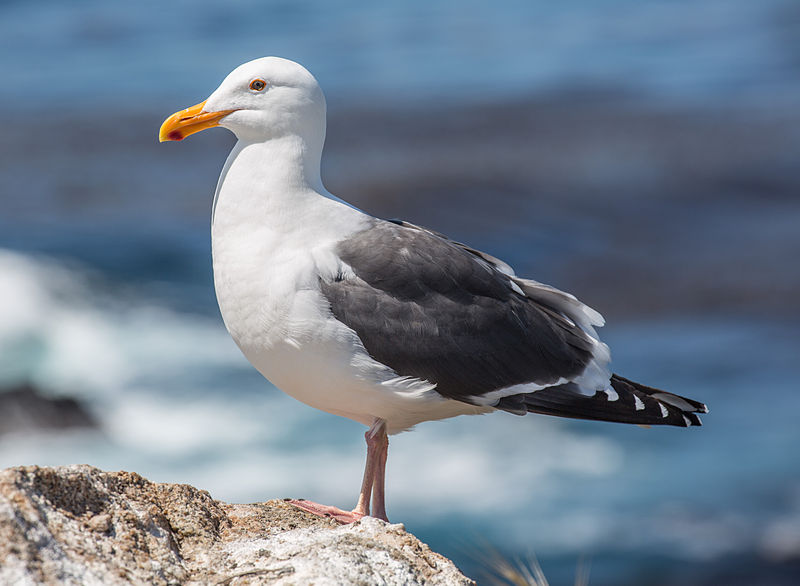
The Western Gull is a majestic seabird found on the West Coast of North America, ranging from British Columbia to Baja California. It has a large white head and stands between 22-27 inches in size.
Its upper parts are gray, while its underparts range from brownish-grey to white depending on the age or sex of the bird.
The most distinguishing feature is its yellow feet, which set it apart from other gulls in the area, such as Larus livens.
When available, these birds feed by scavenging for food, including fish, mollusks, crustaceans, and even carrion.
They also nest near ocean shores, with their eggs hatching anywhere within 28 days after being laid. A beautiful sight to behold at any beach, these birds will surely captivate you with their grandeur.
Scientific classification:
| Kingdom | Animalia |
| Phylum | Chordata |
| Class | Aves |
| Order | Charadriiformes |
| Family | Laridae |
| Genus | Larus |
| Species | L. occidentalis |
Conclusion
California boasts a rich diversity of bird species, with various habitats ranging from coastal areas to mountains, deserts, and forests. The list of 31 common Californian birds provided highlights just a fraction of the avian diversity present in the state.
From the iconic California Quail and Western scrub jay to the majestic Osprey and Great Horned Owl, these birds contribute to California’s landscapes’ ecological richness and natural beauty.